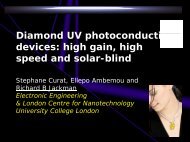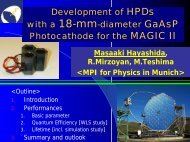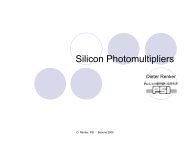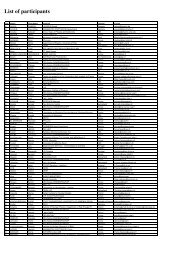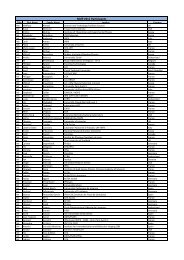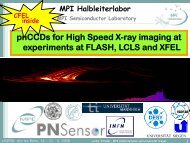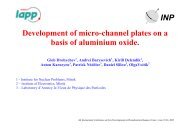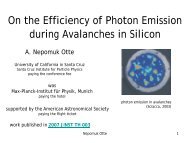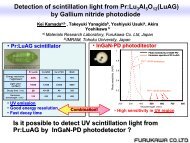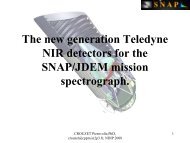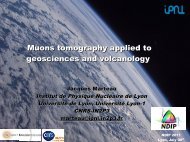Tutorial in Image processing - NDIP 11
Tutorial in Image processing - NDIP 11
Tutorial in Image processing - NDIP 11
You also want an ePaper? Increase the reach of your titles
YUMPU automatically turns print PDFs into web optimized ePapers that Google loves.
Signal and <strong>Image</strong> Process<strong>in</strong>g <strong>in</strong> Astrophysics<br />
Sandr<strong>in</strong>e Pires<br />
sandr<strong>in</strong>e.pires@cea.fr<br />
AIM-CEA Saclay,<br />
France<br />
NDPI 20<strong>11</strong>
Introduction - Deconvolution - Denois<strong>in</strong>g - Miss<strong>in</strong>g data - Compressed Sens<strong>in</strong>g - Source separation<br />
<strong>Image</strong> Process<strong>in</strong>g : Goals<br />
<strong>Image</strong> process<strong>in</strong>g is used once the image acquisition is done by the telescope<br />
✓ Correct from the problems encountered dur<strong>in</strong>g acquisition:<br />
✓ Reduce the <strong>in</strong>strumental and atmospheric effects<br />
✓ Reduce the observation noise<br />
✓ Deal with miss<strong>in</strong>g data (partial sky coverage, defective pixel…)<br />
✓ Extract the useful <strong>in</strong>formation to enable physical <strong>in</strong>terpretation<br />
Compressed sens<strong>in</strong>g<br />
Source separation<br />
=> Impact the <strong>in</strong>strument design<br />
1
Introduction - Deconvolution - Denois<strong>in</strong>g - Miss<strong>in</strong>g data - Compressed Sens<strong>in</strong>g - Source separation<br />
How to reduce atmospheric and<br />
Great Refractor (76 cm) at Nice<br />
observatory<br />
<strong>in</strong>strumental effects ?<br />
Hale Telescope (5 m) at Mont Palomar<br />
observatory (alt. 1706 m), California<br />
Hubble Space Telescope (2.4m)<br />
2
Introduction - Deconvolution - Denois<strong>in</strong>g - Miss<strong>in</strong>g data - Compressed Sens<strong>in</strong>g - Source separation<br />
PSF<br />
PSF correction<br />
Observed image Convolved image<br />
3
Introduction - Deconvolution - Denois<strong>in</strong>g - Miss<strong>in</strong>g data - Compressed Sens<strong>in</strong>g - Source separation<br />
How to reduce the observational noise ?<br />
4
Introduction - Deconvolution - Denois<strong>in</strong>g - Miss<strong>in</strong>g data - Compressed Sens<strong>in</strong>g - Source separation<br />
Standard methods based on a l<strong>in</strong>ear filter<br />
(i.e. Gaussian filter<strong>in</strong>g)<br />
<strong>Image</strong> bruitée Gaussienne <strong>Image</strong> filtrée<br />
<br />
Signal<br />
Signal + noise Gaussian function (σ) Filtered signal<br />
=<br />
5
Introduction - Deconvolution - Denois<strong>in</strong>g - Miss<strong>in</strong>g data - Compressed Sens<strong>in</strong>g - Source separation<br />
Standard methods based on a l<strong>in</strong>ear filter<br />
(i.e. Gaussian filter<strong>in</strong>g)<br />
Signal<br />
Gaussian filtered (σ =2 pixels)<br />
Signal + noise<br />
Gaussian filtered (σ =5 pixels)<br />
6
Introduction - Deconvolution - Denois<strong>in</strong>g - Miss<strong>in</strong>g data - Compressed Sens<strong>in</strong>g - Source separation<br />
Methods based on sparsity<br />
Consider<strong>in</strong>g a transform :<br />
A signal X is sparse <strong>in</strong> a basis Φ<br />
if most of the coefficients α are equal to zero or close to zero<br />
7
Introduction - Deconvolution - Denois<strong>in</strong>g - Miss<strong>in</strong>g data - Compressed Sens<strong>in</strong>g - Source separation<br />
Basic Example<br />
Orig<strong>in</strong>al Noisy signal signal<br />
Fourier Transform<br />
Filtered Signal<br />
8
Introduction - Deconvolution - Denois<strong>in</strong>g - Miss<strong>in</strong>g data - Compressed Sens<strong>in</strong>g - Source separation<br />
Signal and image representations<br />
Local DCT :<br />
Stationary textures<br />
Locally oscillatory<br />
Wavelet Transform<br />
Piecewise smooth<br />
Isotropic structures<br />
Curvelet Transform<br />
Piecewise smooth<br />
Edge structures<br />
9
Introduction - Deconvolution - Denois<strong>in</strong>g - Miss<strong>in</strong>g data - Compressed Sens<strong>in</strong>g - Source separation<br />
Adapted Representations<br />
Test image 1 <strong>Image</strong> test 1 + noise<br />
Wavelet filter<strong>in</strong>g Ridgelet filter<strong>in</strong>g Curvelet filter<strong>in</strong>g<br />
10
Introduction - Deconvolution - Denois<strong>in</strong>g - Miss<strong>in</strong>g data - Compressed Sens<strong>in</strong>g - Source separation<br />
Adapted Representations<br />
<strong>Image</strong> test 2 <strong>Image</strong> test 2 + noise<br />
Wavelet filter<strong>in</strong>g Ridgelet filter<strong>in</strong>g Curvelet filter<strong>in</strong>g<br />
<strong>11</strong>
Introduction - Deconvolution - Denois<strong>in</strong>g - Miss<strong>in</strong>g data - Compressed Sens<strong>in</strong>g - Source separation<br />
Gravitational Lens<strong>in</strong>g effect<br />
observed by the Hubble Space Telescope<br />
Cluster Abell 2218<br />
12
Introduction - Deconvolution - Denois<strong>in</strong>g - Miss<strong>in</strong>g data - Compressed Sens<strong>in</strong>g - Source separation<br />
Weak Gravitational Lens<strong>in</strong>g<br />
Observer Gravitational lens Background galaxies<br />
13
Introduction - Deconvolution - Denois<strong>in</strong>g - Miss<strong>in</strong>g data - Compressed Sens<strong>in</strong>g - Source separation<br />
Dark matter Map<br />
- HST observations -<br />
14
Introduction - Deconvolution - Denois<strong>in</strong>g - Miss<strong>in</strong>g data - Compressed Sens<strong>in</strong>g - Source separation<br />
Miss<strong>in</strong>g data<br />
Causes of miss<strong>in</strong>g data:<br />
Occurrence of defective or dead pixels<br />
Partial sky coverage due to problems <strong>in</strong> the scan strategy<br />
Saturated pixels<br />
Absorption or mask<strong>in</strong>g of the signal by a foreground<br />
Problems caused by miss<strong>in</strong>g data:<br />
Bias and decrease on statistical power<br />
Distortions <strong>in</strong> the frequency doma<strong>in</strong> due to abrupt truncation<br />
Other edge effects <strong>in</strong> multi-scale transforms<br />
How to deal with miss<strong>in</strong>g data?<br />
Correction of the measure by the proportion of miss<strong>in</strong>g data<br />
Other corrections specific to a given measure (i.e. MASTER for<br />
power spectrum estimation)<br />
Inpa<strong>in</strong>t<strong>in</strong>g methods<br />
15
Introduction - Deconvolution - Denois<strong>in</strong>g - Miss<strong>in</strong>g data - Compressed Sens<strong>in</strong>g - Source separation<br />
Inpa<strong>in</strong>t<strong>in</strong>g based on sparsity<br />
S<strong>in</strong>e curve Truncated s<strong>in</strong>e curve<br />
Fourier transform of the s<strong>in</strong>e curve Fourier transform of the truncated s<strong>in</strong>e curve<br />
16
Introduction - Deconvolution - Denois<strong>in</strong>g - Miss<strong>in</strong>g data - Compressed Sens<strong>in</strong>g - Source separation<br />
Light curve<br />
(time series)<br />
Zoom on the Light curve<br />
Power spectrum<br />
Inpa<strong>in</strong>t<strong>in</strong>g on asterosismic data<br />
Orig<strong>in</strong>al (red) and masked (black) data<br />
Inpa<strong>in</strong>ted data (black)<br />
17
Introduction - Deconvolution - Denois<strong>in</strong>g - Miss<strong>in</strong>g data - Compressed Sens<strong>in</strong>g - Source separation<br />
Miss<strong>in</strong>g data<br />
In Weak Lens<strong>in</strong>g<br />
18
Introduction - Deconvolution - Denois<strong>in</strong>g - Miss<strong>in</strong>g data - Compressed Sens<strong>in</strong>g - Source separation<br />
Inpa<strong>in</strong>t<strong>in</strong>g <strong>in</strong> Weak Lens<strong>in</strong>g data<br />
Which image is the orig<strong>in</strong>al one ?<br />
19
Introduction - Deconvolution - Denois<strong>in</strong>g - Miss<strong>in</strong>g data - Compressed Sens<strong>in</strong>g - Source separation<br />
Inpa<strong>in</strong>t<strong>in</strong>g <strong>in</strong> Weak Lens<strong>in</strong>g data<br />
20
Introduction - Deconvolution - Denois<strong>in</strong>g - Miss<strong>in</strong>g data - Compressed Sens<strong>in</strong>g - Source separation<br />
Compressed sens<strong>in</strong>g<br />
Shannon-Nyquist sampl<strong>in</strong>g theorem :<br />
No loss of <strong>in</strong>formation if the sampl<strong>in</strong>g frequency is two times the highest<br />
frequency of the signal<br />
The number of sensors is determ<strong>in</strong>ed by the resolution<br />
Can we get an exact recovery from a smaller number of measurements ? YES !<br />
Compressed sens<strong>in</strong>g theorem :<br />
No loss of <strong>in</strong>formation if :<br />
- the signal is local and coherent.<br />
- the measurements are global and decoherent.<br />
The number of measurements is about K. log(N) where K is the number of<br />
non-zero entries <strong>in</strong> the signal.<br />
21
Introduction - Deconvolution - Denois<strong>in</strong>g - Miss<strong>in</strong>g data - Compressed Sens<strong>in</strong>g - Source separation<br />
Compressed sens<strong>in</strong>g:<br />
A non l<strong>in</strong>ear sampl<strong>in</strong>g theorem<br />
M x 1<br />
measurements<br />
“Signals (x) with exactly K components different from zero<br />
can be recovered perfectly from ~ K log N <strong>in</strong>coherent measurements”<br />
Replace samples by few l<strong>in</strong>ear projections y = Θ x = MR x<br />
x’<br />
M<br />
0<br />
Reconstruction via a non l<strong>in</strong>ear process<strong>in</strong>g:<br />
=<br />
R<br />
N x 1<br />
signal<br />
K<br />
non-zero<br />
entries<br />
22
Introduction - Deconvolution - Denois<strong>in</strong>g - Miss<strong>in</strong>g data - Compressed Sens<strong>in</strong>g - Source separation<br />
M x 1<br />
measurements<br />
Compressed Sens<strong>in</strong>g<br />
Signal Fourier M <strong>in</strong>coherent (x) transform with K non-zero measurements of the Signal coefficients<br />
M<br />
FOURIER<br />
R<br />
0<br />
N x 1<br />
signal<br />
K<br />
non-zero<br />
entries<br />
23
Introduction - Deconvolution - Denois<strong>in</strong>g - Miss<strong>in</strong>g data - Compressed Sens<strong>in</strong>g - Source separation<br />
M x 1<br />
measurements<br />
Soft Compressed sens<strong>in</strong>g:<br />
“Sparse signals (x) with exactly K coefficients (α) different from zero<br />
can be recovered perfectly from ~ K log N <strong>in</strong>coherent measurements”<br />
M<br />
0<br />
R<br />
Reconstruction via a non l<strong>in</strong>ear process<strong>in</strong>g:<br />
24
Introduction - Deconvolution - Denois<strong>in</strong>g - Miss<strong>in</strong>g data - Compressed Sens<strong>in</strong>g - Source separation<br />
8<br />
Compressed sens<strong>in</strong>g to transfer<br />
spatial data to the earth<br />
A field is obta<strong>in</strong>ed every 25 m<strong>in</strong> and is composed by<br />
60.000 shifted images (16x16 pixels)<br />
The official pipel<strong>in</strong>e consists of only transmitt<strong>in</strong>g an averaged<br />
image obta<strong>in</strong>ed from 8 consecutives shifted images.<br />
25
Introduction - Deconvolution - Denois<strong>in</strong>g - Miss<strong>in</strong>g data - Compressed Sens<strong>in</strong>g - Source separation<br />
Compressed sens<strong>in</strong>g to transfer<br />
spatial data to the earth<br />
Good solution for on board data compression (very fast)<br />
Map from uncompressed data Official pipel<strong>in</strong>e reconstruction:<br />
averag<strong>in</strong>g<br />
Very robust to bit loss dur<strong>in</strong>g transfer<br />
All measurements are equally (un) important<br />
Compressed sens<strong>in</strong>g reconstruction<br />
26
Introduction - Deconvolution - Denois<strong>in</strong>g - Miss<strong>in</strong>g data - Compressed Sens<strong>in</strong>g - Source separation<br />
Source Separation<br />
X = A S<br />
4 sources<br />
4 random mixtures<br />
27
Introduction - Deconvolution - Denois<strong>in</strong>g - Miss<strong>in</strong>g data - Compressed Sens<strong>in</strong>g - Source separation<br />
Source Separation<br />
28
30 GHz<br />
Introduction - Deconvolution - Denois<strong>in</strong>g - Miss<strong>in</strong>g data - Compressed Sens<strong>in</strong>g - Source separation<br />
Source Separation:<br />
Cosmic Microwave Background<br />
44 GHz 70 GHz<br />
LFI<br />
100 GHz<br />
143 GHz<br />
217 GHz 353 GHz<br />
HFI<br />
545 GHz<br />
857 GHz 29
Introduction - Deconvolution - Denois<strong>in</strong>g - Miss<strong>in</strong>g data - Compressed Sens<strong>in</strong>g - Source separation<br />
Input CMB map<br />
CMB map estimated<br />
by GMCA<br />
Source Separation:<br />
Cosmic Microwave Background<br />
30
INSTRUMENTATION<br />
The development of<br />
new <strong>in</strong>struments more<br />
and more accurate<br />
improves the quality<br />
of the observations<br />
Conclusion<br />
IMAGE PROCESSING<br />
Is used to extract the<br />
useful <strong>in</strong>formation to<br />
help <strong>in</strong> the physical<br />
<strong>in</strong>terpretation<br />
IMAGE PROCESSING<br />
Improves the quality of<br />
the image after<br />
acquisition by the<br />
<strong>in</strong>strument<br />
31
END<br />
32



